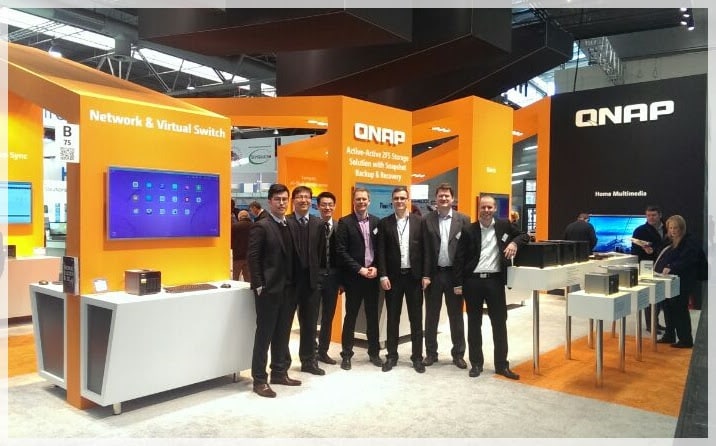At CeBIT 2016, QNAP Systems has unveiled a plethora of new NAS storage innovations, such as the new Thunderbolt 2-compatible NAS, an M.2 SSD NASbook, the Enterprise ZFS NAS with dual active controllers, and many new features including network-defined Virtual JBOD, QPulse unified remote server management, Linux Station, and Hybrid Backup Sync. QNAP also joined Seagate and WD to demonstrate QNAP NAS solutions with a variety of HDDs.

The TVS-x82T Thunderbolt 2 NAS leverages the latest Intel 6th generation Core processor and is equipped with an enhanced hardware design that QNAP indicates improves computing power and system performance. In addition, the TVS-x82T series features dual 10GbE ports, built-in SATA M.2 SSD, dedicated 2.5” SSD trays, compartmentalized smart cooling, tool-less hard drive trays, and three HDMI ports (including one HDMI 2.0). The TVS-x82T series is also designed to handle 4K, 60fps videos, and high-speed sharing.
The compact and mobile-ready TBS-453A features an Intel Celeron N3150 quad-core processor and up to 8GB RAM and offers comprehensive NAS functions with RAID protection. QNAP adds that it can also act as a switch and share network access with multiple clients. The TBS-453A supports up to four M.2 SSDs, features dual HDMI output and 4K H.264 video display and transcoding abilities, and is compatible with HDMI-enabled desktop operating systems including Ubuntu.
QNAP’s ZFS-enabled ES1640dc features dual-controllers, making it ideal for mission-critical business applications that require both high reliability and high availability. Coupled with Intel Xeon E5 processors, HPE Helion compatibility and full virtualization environment support, QNAP claims that the ES1640dc provides “real business-class” cloud computing data storage.
In addition, the ES1640dc leverages the new QES operating system, which enables virtually limitless snapshots, block-level data deduplication, and thin provisioning with reclaim.
Virtual JBOD (VJBOD) gives users the ability to mount iSCSI LUNs from up to eight NAS units to a host NAS as virtual disks. From there, they can create virtual Storage Pools as local disks for shares, applications, and even creating another LUN.
QPulse is the company’s centralized Remote Server Management solution specifically designed for IT teams that rely on computing devices including servers, PCs, embedded PCs, and thin clients. QNAP indicates that it offers a single-point solution to discover, map, monitor and manage all of the critical computing devices on the network. It also offers a customizable dashboard that helps to simplify server management, increase visibility for the health status of mission-critical servers, map discovered devices in a graphic topology diagram, and provides a remote KVM solution for IPMI and KVM recording/playback.
Q'center is a lighter solution that provides home or business users with the ability to monitor and manage one or multiple QNAP NAS from a host NAS, server, or laptop with the Q'center app or virtual appliance. Users can centrally analyze storage space usage, monitor hardware and disk health, customize system settings and firmware, and deploy apps to one or more NAS units.
Linux Station is an accessible platform that can be used to install the Ubuntu OS and services. QNAP adds that it can turn a QNAP NAS into a gateway for IoT solutions to other smart devices. Using an HDMI display, the Ubuntu desktop can be output to the QNAP NAS, which allows users to freely install and develop more apps on an open-source Linux platform.
QNAP Hybrid Backup Sync helps enhance the efficiency of data backup, file synchronization and disaster recovery, restoration and synchronization; all into a single app for the easy transfer of data to local, remote and cloud storage. QNAP indicates that this will give users an easier way to arrange backup tasks, a more efficient management with multi-version backup, flexible job scheduling, and smart data reduction.
Availability
The availability of TVS-x82T series, TBS-453A, ES1640dc, VJBOD, QPulse and Hybrid Backup Sync will be given release dates individually in the near future.




 Amazon
Amazon